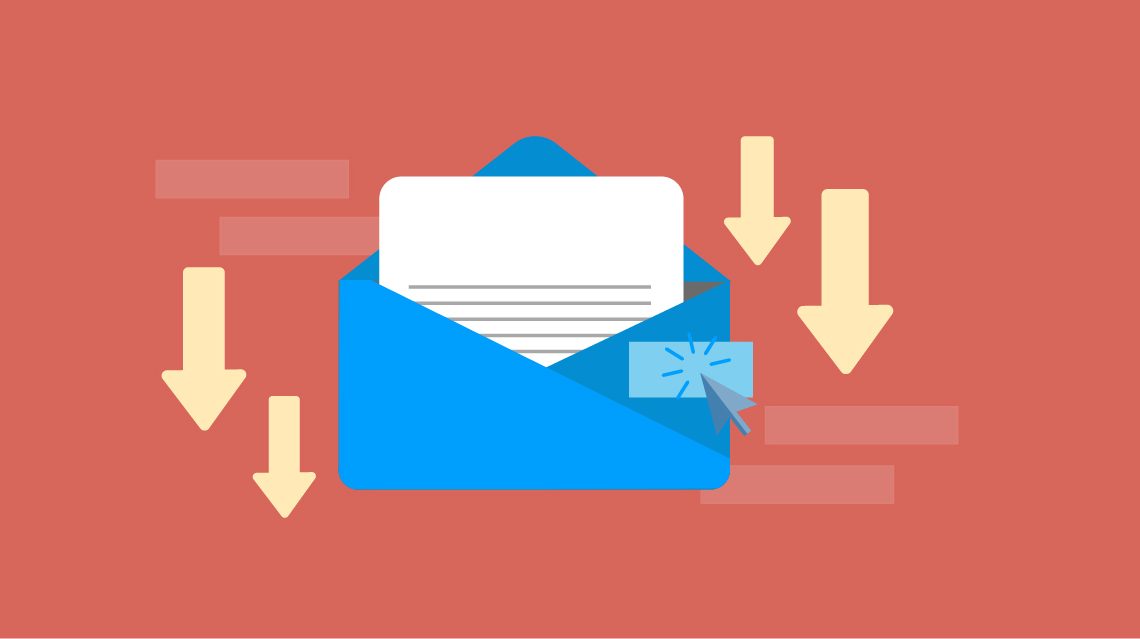
4 Reasons Your Email Open Rate Is Decreasing
July 7, 2020Hitting send on an email you’ve spent days perfecting is a great feeling, but that marketer’s high comes crumbling down after you see your open rate is lower than usual. 
What happened?
First, it’s important to know this happens to almost every marketer. At some point, you’re going to see lower than usual open rates and you’re going to wonder what went wrong.
Second, it’s necessary to come at this with an open mind ready to fix a few problems instead of thinking there’s only ONE problem. This is especially true if you’ve been seeing lower than usual open rates for a few days, weeks, or months.
Let’s take a look at 4 different elements of your email that may be causing your email open rate to decrease, and how you can fix them so you can get back to the open rates you used to see.
#1: Your Email Is Too BigIf you’ve been successfully sending emails and seeing a great open rate, but since sending one particular email your open rate has tanked—this could be a very easy problem to fix.
Emails sent to Gmail addresses get “clipped” when they’re bigger than 102KB. Considering Gmail has 1.5 billion users, this is a worthy problem to focus on fixing. When an email is clipped, a Gmail user can’t see the entire email like they can a <102KB email. They have to click on “View Entire Message” to load the email in their browser.
Here’s what a Gmail user sees when an email gets clipped:

Unless a Gmail user clicks on the “View Entire Message” link, this DOES NOT count as an email open. From experience, we can tell you that Gmail users don’t favor clicking on that blue hyperlink. They prefer to have their entire email accessible as soon as they open it.
To avoid having your emails clipped, make sure they’re less than 102KB large by:
Sending yourself previews that you view in Gmail to make sure the entire message loads without the [Message clipped] notificationUsing an HTML sizing tool to see how large your email isThere are a few reasons your email may be too large. By removing individual blocks from your email (text, images, spacers, etc.) you can reduce the size of your email. For example, if you have 3 separate text blocks right after each other and your email is getting clipped, try to figure out how you can put all of that text into one block.
If your email open rate bounced right back to where it used to be—GREAT! This tells you that the only reason your open rate decreased was that your subscribers were avoiding clicking on that “View Entire Message” link. Easy fix. 
If your email open rate is still really low, keep reading to see how else you can push your open rate back up.
#2: You’re Using Too Many Spam WordsThis is a really easy problem to run into without realizing it. If your email campaign has too many spam words in it, email providers (like Gmail, Yahoo, Hey, etc.) are going to toss your email right into your subscriber’s junk folder. It’s their job to protect their users from spam emails that promise them millions of dollars from a king far, far away.
To protect their users, they mark hundreds of words and phrases as spam. Here are just a few of the words you may be using that you don’t realize are creating spam red flags:
AffordableApply nowBonusClick hereFree accessMoneyPromiseUnlimitedWinUrgentPurchaseOpenIncrease salesIncrease trafficTake actionTrialOrder nowSome email hosting platforms like ActiveCampaign will run your email content through a spam test before you hit send so you know your email passes the test. Removing as many of these spam words as possible from your emails will keep your email out of the junk folder and in the inbox.
If your email fits like a swaddled newborn within 102KB and you’ve taken out anything that could be considered spam—but you’re STILL seeing a decreased open rate, let’s test out a few more options starting with your subject lines.
 #3: Your Subject Lines Aren’t Doing Their Job
#3: Your Subject Lines Aren’t Doing Their Job
Your subject lines really have one, single job: get someone to open your email. Optimized at 41 characters or 7 words, they make Tweets look like full-on essays. And considering how small they are, they have to pack a punch to do their job.
At DigitalMarketer, we’re alwayyyyys testing out new subject line strategies to see what’s working well and what’s not.
We’ve figured out there are 5 email subject lines that tend to do really well:
#1: The Dead-On Offer Subject Line
These subject lines focus entirely on what you’re offering, and nothing else.
Example: Email Marketing Announcement: Enrollment is Back Open (21.56% open rate)
#2: Curiosity/Blind Subject Line
Subject lines that make people curious about what’s inside your email OR totally unsure of what’s going on and wanting to know more tend to do really well.
Curiosity Example: Netflix’s Huge Homepage Fail
Blind Example: Cut Off (one of the best performing subject lines in our promotional emails in 2019)
#3: Self Interest Subject Line
Your subscribers love to know what’s in it for THEM if they open up your email.
Example: Up to 85% OFF Our Best Copywriting Strategies
#4: Urgency Subject Line
A subject line that stresses urgency makes subscribers interested in your offer motivated to open your email so they don’t miss out on a good deal.
Example: LAST CHANCE: DigitalMarketer Lab goes off the Market in 3…2…1…
#5: Story/Relevance Subject Line
These subject lines bring the reader into a story they’re curious about, just make sure you’re delivering on the story you promised to tell.
Example: Here’s the REAL Reason Amazon is Buying Whole Foods
Use your email platform’s A/B testing tool to see which subject lines are able to improve your open rate. You can set your A/B test to automatically switch to the best performing subject line after a set number of hours so you don’t have to worry about defaulting the best performing subject line a few hours after hitting send.
If your subject lines are spot on and you’re still seeing a lower than usual open rate, it’s time to take a look at your content.
#4: Your Subscribers Aren’t Excited to Read Your Email AnymoreWe know, it hurts to hear your subscribers aren’t loving your content but at the end of the day—who is the content for? Them. What does that mean? It’s time to figure out what makes them get that little surge of excitement every time they hear a ping and see your business’s name.
Your subscribers may not be loving your content for a few reasons. The best way to figure out what went wrong is to ask them. Using a survey platform you can ASK them what they want to read from you. In your survey, make sure to ask specific questions and to give an option for them to write their own suggestions.
For example, if we were surveying our audience we’d ask them if they wanted to read more content on:
Digital marketing trendsGoogle SEO updatesFacebook algorithm updatesCase studies on successful digital marketing strategiesInfluencer marketing strategiesThen, we’d ask them, “Is there anything else you want us to cover?” and we’d give them the option to type in their answers.
Another way to ensure your subscribers are going to want to read what you send them is to segment subscribers as they come into your list. Instead of having a huge master list of every subscriber that you send every email to, segment your list based on how they came into it.
For example, if subscribers are coming into your list for a specific lead magnet or offer, create a segment for them. Then, you can make sure the emails they get from you are relevant to that lead magnet or offer. This is a win-win because you’re going to know exactly what content they’re interested in and they’re going to get read emails they’re actually interested in.
Now that you’ve gone through your email size, spam word usage, subject lines, and content—do you still have a lower than usual open rate?
If you do, here are a few more email elements to take a look at to get that open rate back up to where it was:
DeliverabilitySender reputation and scoreThe frequency that you’re sending emailsTrackingA decreased open rate doesn’t mean you have to give up on your list. It just means that something is wrong, and you need to go into research mode to figure out what it is and how to fix it.
You’ll get back to getting excited to hit that send button, knowing your subscribers are BEYOND excited to see your name pop up in their inbox.

The post 4 Reasons Your Email Open Rate Is Decreasing appeared first on DigitalMarketer.
Read more: digitalmarketer.com
A quick note about the reviews I do on this site. The product vendors may give me access to their products for free in order for me to do my review, alternatively, I may have bought the product myself. However I make no promises to vendors regarding what I write in my review. Should you click a link that takes you to a sales page for a paid product for sale this link will be an affiliate link and I will be paid a percentage of the sales price should you decide to invest in it.




